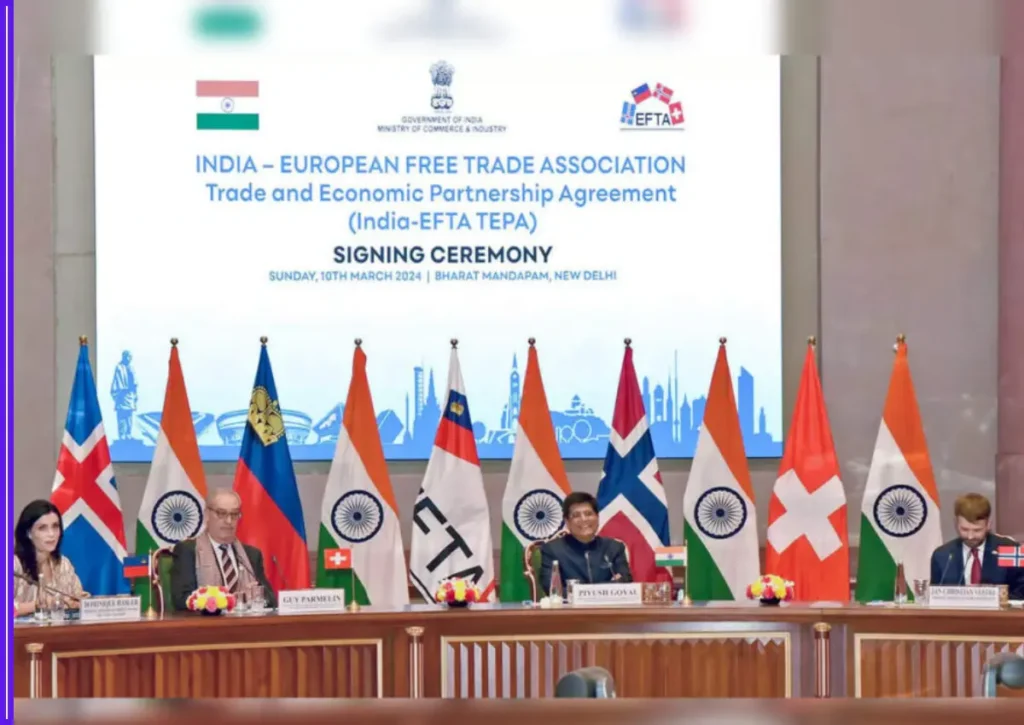In September 2024, the Swiss Federal Council began the process of ratifying the landmark India–EFTA Trade and Economic Partnership Agreement (TEPA). What started as a cautious step by Switzerland’s government has now transformed into a historic reality, with the deal set to come into effect in late 2025. The agreement marks one of the most ambitious trade pacts ever signed by India, promising billions in investment, millions of new jobs, and a stronger strategic partnership between India and the European Free Trade Association (EFTA).
This article traces the journey from the early ratification stages in Switzerland to the final steps that will bring the deal into force, while also exploring what it means for India, Switzerland, and the broader global economy.

A Quick Recap: What Is the EFTA?
The European Free Trade Association (EFTA) is a regional trade bloc that consists of four non-EU countries: Switzerland, Norway, Iceland, and Liechtenstein. Unlike the European Union, EFTA does not function as a political union but instead focuses on creating trade opportunities among member states and with external partners.
India’s partnership with EFTA has been in discussion for more than 16 years, with multiple rounds of negotiations often stalling. It was only in March 2024 that India and EFTA finally signed the TEPA in Geneva. The agreement is unique because, for the first time, EFTA countries offered guaranteed investments of $100 billion in India over 15 years, linked with job creation targets.
September 2024: Swiss Federal Council Approves Submission
On September 5, 2024, the Swiss Federal Council officially approved the TEPA and submitted it to the country’s Parliament for ratification. This was a major first step, as Switzerland holds the largest share of trade with India among EFTA members.
The Council highlighted that the agreement would give Swiss exporters greater access to the Indian market, reduce tariffs, and open opportunities in pharmaceuticals, watches, machinery, and financial services. For India, Switzerland’s ratification meant the pact was moving beyond signatures and closer to legal reality.
March 2025: Swiss Parliament Gives Its Approval
After months of debate, both chambers of the Swiss Parliament approved the TEPA in March 2025. The decision signaled strong political support in Switzerland for deepening ties with India.
Some concerns were raised about labor rights, environmental standards, and the binding nature of EFTA’s investment commitments, but overall, the deal was seen as a win-win. The approval also reassured Indian policymakers that Europe’s most significant financial hub was firmly backing the agreement.
July 2025: Final Ratification Without a Referendum
By July 2025, Switzerland completed its ratification process. Unlike some other agreements that may trigger a national referendum, this deal passed without such a challenge. That meant Switzerland’s role in the ratification process was complete, clearing the way for the pact to move forward.
At the same time, India deposited its instrument of ratification with Norway, which serves as the official treaty depository for EFTA. With this step, all sides had fulfilled their domestic procedures.
September–October 2025: The Deal Comes Into Force
With all four EFTA members and India completing ratification, the TEPA is scheduled to enter into force in late 2025. Official announcements vary slightly: India’s Commerce Minister Piyush Goyal indicated September 2025 as the start, while EFTA’s official communication confirmed October 1, 2025.
Either way, within weeks, the agreement will be active—bringing into effect one of the most forward-looking trade deals in India’s modern history.
What the Deal Promises
The India–EFTA TEPA is groundbreaking in several ways:
- $100 Billion Investment Commitment EFTA members pledged to invest at least $100 billion in India over 15 years. This is tied to the creation of 1 million new jobs, a first-of-its-kind provision in global trade agreements.
- Tariff Reductions India will gradually reduce tariffs on key imports from Switzerland and other EFTA nations. In return, Indian exporters, particularly in textiles, pharmaceuticals, and IT services, will gain preferential access to wealthy European markets.
- Boost for Sectors
- India: Textiles, leather, gems & jewelry, IT, and agriculture.
- EFTA: Watches, precision machinery, financial services, and pharmaceuticals.
- Intellectual Property & Services The deal also strengthens cooperation in intellectual property, digital trade, financial services, and sustainable development.
- Strategic Geopolitical Value For India, this is a gateway into Europe at a time when its EU negotiations have been stuck for years. For Switzerland and EFTA, it secures a presence in one of the world’s fastest-growing markets.
Why It Matters for India
India has signed several trade agreements in recent years—with UAE, Australia, and Mauritius—but the EFTA deal is the most ambitious so far. The guaranteed investment clause sets it apart from traditional free trade agreements.
For India, which aims to become a $5 trillion economy, this partnership not only opens new export markets but also ensures significant inflows of foreign capital. The expected job creation aligns with India’s demographic advantage, where millions of young workers enter the job market each year.
Why It Matters for Switzerland and EFTA
For Switzerland, India is a fast-expanding market of 1.4 billion people, offering huge opportunities for its precision goods, luxury brands, and financial services.
Norway, with its sovereign wealth fund, sees India as a stable destination for long-term investments. Iceland and Liechtenstein, though smaller players, benefit from having greater access to India’s services and industrial markets through collective bargaining under EFTA.
Looking Ahead: What Happens Next
The India–EFTA TEPA will officially reshape trade flows starting late 2025. In the short term, businesses will need to adapt to new tariff structures and compliance standards. Over the medium term, the deal is expected to:
- Drive billions in Swiss and Nordic investments into India’s manufacturing and services.
- Provide Indian exporters greater foothold in Europe.
- Strengthen India’s hand in future trade negotiations with the EU and UK.
Experts also warn that the true success of the deal will depend on implementation and monitoring. Ensuring that the promised $100 billion actually materializes, and that job creation targets are met, will require strong accountability measures on both sides.
Conclusion
What began in September 2024, when the Swiss Federal Council first initiated the ratification process, has now turned into a transformational trade pact ready to take effect in 2025.
The India–EFTA agreement is more than just another free trade deal—it is a model for how investment, jobs, and sustainability can be embedded into international trade partnerships. As India and EFTA prepare to operationalize the pact in the coming months, the world will be watching closely to see how this ambitious agreement shapes the future of global trade.









